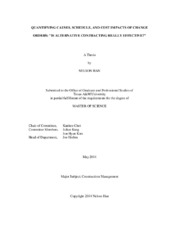| dc.description.abstract | The most professions who are engaged in the highway construction industry
would commonly concur with an idea that the project cannot be delivered with no
change. Regardless of considering different contract methods or what so ever, contract
change orders (CCO) are yet inevitable due to unforeseen utility conflicts, unpredicted
geology, and other unanticipated conditions. No matter of the project location and/or
condition, the CCO negatively affects the project in aspects of project cost and schedule.
The main purpose of this study is to carefully examine the influences of change
orders in infrastructure development projects in the schedule and cost aspects. The aim
of this study starts with collecting Florida Department of Transportation’s (FDOT) 9
years of solid data that contains abundant information of CCO in highway projects
completed in the state of Florida. In addition to the data, it contains 2,990 infrastructure
projects completed between 2002 and 2011, 43,000 change order types, 8 contract
methods including conventional (D/B/B), Design-Build (D/B), Incentive/Disincentive
(I/D), No Excuse Bonus, Lump Sum, etc., and 7 major types of projects. These detailed
and vast data was utilized to evaluate each method's performances affecting projects on
cost and schedule aspects by carrying quantitative analysis, such as graphs, box plots, etc.
Lastly, the research hypothesis test, which utilized regression analyses, Q-Q plots,
scatterplot matrixes, etc., was conducted to verify the data variation, normal distribution,
equal variances, correlation, etc.
The research results reveal that the innovative methods perform better than
conventional in aspects of saving project cost and time. In addition to the innovative
methods, D/B is the most effective method that saves both cost and time of projects. I/D
compresses project duration but often causes project cost overrun. And Lump Sum
significantly saves the project cost but causes project schedule overrun. This study will
help interstate transportation agencies with a proper guideline to choose an ideal delivery
or contracting method for a project. By providing the information of each method’s
advantages and disadvantages, it is expected to significantly reduce the agencies’ time
and expenses required to deliver projects. | en |


